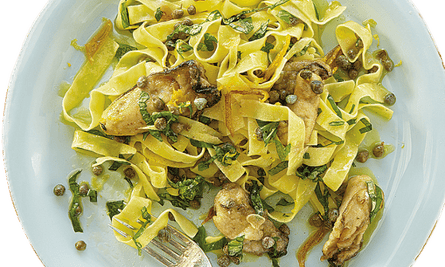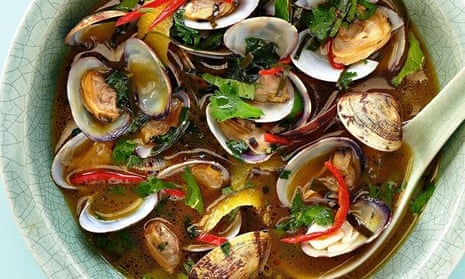With the holidays less than two weeks away, your thoughts are probably turning to family, friends and feasting. Either that, or you’re planning on escaping it all by jetting off to sunnier climes. But even if your dreams of flight can’t be realised, dinner is a great way to transport you abroad.
Clams, mussels and oysters are particularly good for this. These trusty bivalves make perfect sense in all manner of cuisines, and can take you just about wherever you fancy. If you want nothing more than a hop across the Channel, a classic moules marinières, with its butter-softened shallots, thyme and bay, plus some white wine or dry cider, will do the trick. Or head down to the south-east of France, and bake your mussels Provence-style, with a scattering of parsley, gruyère and breadcrumbs on top. While you’re down here, bouillabaisse, the classic Provençal fish stew, or Spanish paella will sate anyone wanting something a bit more substantial and warming from their mussels, with saffron and chilli providing the golden glow all sun-lovers crave. Spaghetti alle vongole – spaghetti with clams simply cooked with chilli, garlic and parsley – will take you over to Italy.
If your sights are set on going farther afield, both clams and mussels love being paired with the flavours of Thailand (coconut milk, Thai basil, lemongrass, kaffir lime leaves) in a soup, broth or stew; or sail across the Indian Ocean to south India by tucking into an aromatic rasam soup, with its lentils, spices and curry leaves. Oysters, too, can take you to Asia: the tapioca starch-thickened oyster omelettes of Malaysia are one of my all-time favourite street foods. For transatlantic adventurers, a creamy New England chowder is just the ticket: clams and salted belly pork or streaky bacon, cooked in butter with onions, spuds and milk.
As with the suitcase you pack to take on holiday, a bivalve’s shell must be shut firmly tight and not interfered with before the journey starts. Don’t forget to pack the cream, either – sun cream, double cream, coconut cream – and remember that less is often more when it comes to cooking, be that in the sun or in the pot.
If you prefer a staycation, start a festive meal with angels on horseback – oysters wrapped in streaky bacon. The world may be your oyster, but sometimes the most comforting things are those you find at home.
Clams in kaffir lime and Thai basil broth
I have discarded half the clam shells here, to make the dish easier to eat, but you don’t need to, so long as you are not on a first date and don’t mind a bit of slurping. Serve with a bowl of sticky rice or crusty bread, to mop up the juices. Serves four.
70g ghee (or clarified butter)
4 large cloves garlic, peeled and thinly sliced
3 large mild red chillies, deseeded and thinly sliced
Long shaved zest of 1 lemon
7 fresh (or frozen) kaffir lime leaves, stems removed and finely shredded
200ml dry white wine
500ml chicken stock
½ tsp caster sugar
Salt
1kg clams, washed, with any broken or open clams discarded
20g coriander, roughly chopped
20g Thai basil, shredded
1 tbsp lemon juice
Put 30g of ghee in a large saucepan for which you have a lid, and put on a medium-high flame. Once the ghee starts to froth, add the garlic, chillies, lemon zest and lime leaves, and fry for three minutes, until the garlic starts to brown. Pour in the wine, stock and sugar, add a third of a teaspoon of salt, and bring to a boil. Add the clams, cover and boil for three minutes, until the clams open up. Remove from the heat and use a slotted spoon to lift the clams into a large bowl. Remove half the clams from their shells, discarding the empty shells.
Return the pan to a medium-high heat, add the remaining ghee and the fresh herbs, and boil for two minutes. Remove from the heat, stir in the lemon juice, pour over the clams and serve at once.
Battered mussels with walnut tarator
This is a show-stealing starter or snack, and the mussels’ seriously crisp crust adds to the drama. Tarator is delicious but very rich, so leave it out if you’re feeling virtuous. Serves four.
430ml lager
1kg mussels, well washed, with broken ones discarded
100g plain flour
1 tsp dried chilli flakes
½ tsp bicarbonate of soda
Salt
1 egg yolk
400ml sunflower oil
1 lemon, cut into 4 wedges, to serve
For the walnut tarator
50g walnuts
30g fresh white breadcrumbs
1 garlic clove, peeled and crushed
1½ tbsp white-wine vinegar
70ml olive oil
Put all the tarator ingredients apart from oil in the small bowl of a food processor, add a pinch of salt and blitz to combine. With the machine running, slowly add the oil until you have a thick but textured sauce, then set aside.
Pour 250ml of lager into a large saucepan for which you have a lid, and put on a high heat. Once boiling, add the mussels, cover and cook rapidly for three to four minutes, until all the shells have opened up. Pick the cooked mussels from their shells and set aside; discard the liquid and shells.
Put the flour, chilli and bicarb in a bowl with half a teaspoon of salt. Add the egg yolk and slowly pour in the remaining lager, whisking all the time, until you have a smooth, thick batter. Stir in the mussels.
Pour the oil into a medium saucepan and put on a medium heat. Once hot, use a slotted spoon to drop 10 battered mussels into the hot oil: don’t be tempted to add any more, because they will stick together if the pan is overcrowded. Fry for three to four minutes, turning once, until golden-brown, then use another slotted spoon to transfer the mussels to a plate lined with kitchen paper. Keep somewhere warm while you cook the remaining mussels.
Serve warm, with a bowl of tarator alongside for dipping and a wedge of lemon for squeezing over.
Fettuccine with oysters and lemon

Serves four as a starter.
1½ tbsp cornflour
1½ tbsp plain flour
18 shucked oysters, patted dry; reserve the liquid from the shells
Salt and white pepper
120ml olive oil
30g unsalted butter
3 large cloves garlic, peeled and thinly sliced
Long shaved strip of skin from 1 lemon, plus the finely grated zest of 1 lemon (avoid the white pith)
15 sprigs lemon (or regular) thyme
250g fettuccine
3 tbsp lemon juice
3 tbsp baby capers (or regular capers, roughly chopped)
40g basil leaves, shredded
Toss the cornflour, plain flour and oysters in a bowl with half a teaspoon of salt, and set aside.
Pour a third of the oil into a small saucepan and put on a medium-high flame. Once hot, add three or four oysters and fry for a minute and a half, turning once halfway through, until golden-brown on both sides. With a slotted spoon, transfer to a bowl and cook the remaining oysters.
Discard any oil left in the pan, wipe it down, then add the butter and the remaining oil, and put on a medium heat. Once hot, add the garlic, lemon strip and thyme, and fry for three to four minutes, stirring constantly, until the garlic starts to turn golden and the lemon and thyme are crisp. Take off the heat and discard the thyme.
Bring a medium saucepan of salted water to a boil, add the pasta and cook until al dente. Drain, reserving some of the cooking water, then return the pasta to the pan with three or four tablespoons of its cooking water. Add the oysters, a teaspoon of the liquid from their shells, the infused oil, the grated lemon zest and juice, capers, and a quarter-teaspoon of white pepper. Toss, stir through the basil and serve at once.
Yotam Ottolenghi is chef/patron of Ottolenghi and Nopi in London.
Follow Yotam on Twitter.

Comments (…)
Sign in or create your Guardian account to join the discussion